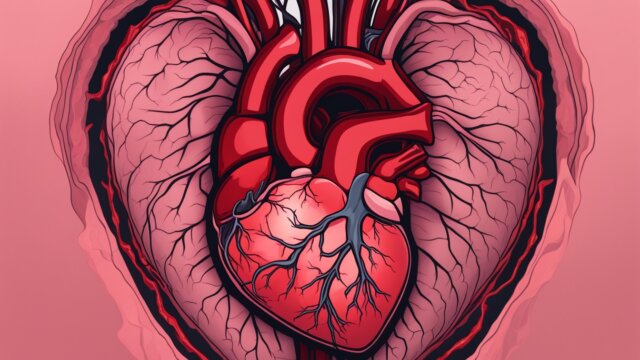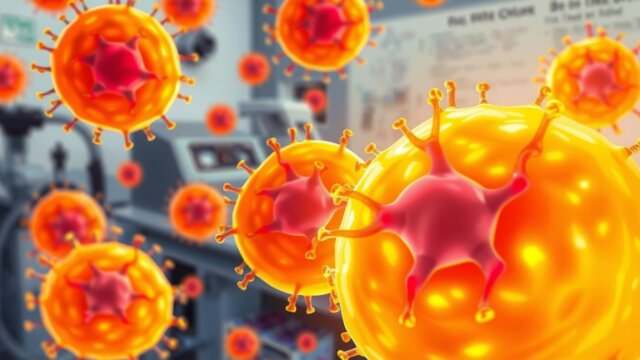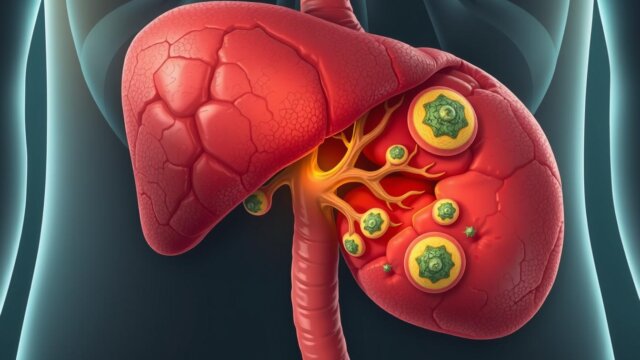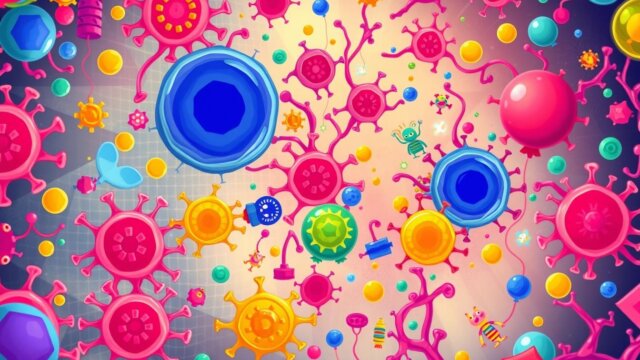FTC disclaimer: This post may contains affiliate links and we will be compensated if you click on a link and make a purchase.
Carcinoma is the most common cancer type, making up 80% to 90% of all cancer cases worldwide. These tumors grow in the tissue that covers organs, passageways, and the skin. They can appear in places like the lungs, breasts, prostate, colon, and pancreas, making it a big health issue.
The main cause of carcinoma is genetic changes or mutations. These changes make cells grow too fast and not stop, and they also mess up DNA repair. These changes can come from family history or from things like smoking, radiation, viruses, and obesity.
Key Takeaways
- Carcinoma is the most common type of cancer, accounting for 80-90% of all cancer diagnoses.
- Carcinoma forms in epithelial tissue, which lines organs, internal passageways, and the skin.
- Genetic mutations that alter cell growth and DNA repair are the underlying cause of carcinoma.
- Carcinoma can develop in various locations, including the lungs, breasts, prostate, colon, and pancreas.
- Factors such as smoking, radiation, viruses, carcinogens, obesity, hormones, and chronic inflammation can contribute to the development of carcinoma.
Carcinoma: A Comprehensive Overview
Carcinoma is a type of cancer that starts in the epithelial tissue, which lines organs, internal passageways, and the skin. It’s a common cancer, accounting for 80-90% of all cases. Knowing about the different types of carcinoma is key to finding, diagnosing, and treating it well.
What is Carcinoma?
Carcinoma is a cancer that starts in the epithelial cells. These cells cover the outer layer of the skin and the lining of organs and structures. They help with protection, secretion, and absorption. When these cells grow and divide too much, they can form a tumor, leading to carcinoma.
Types of Carcinoma
There are many types of carcinoma, each with its own traits and effects. Some common ones include:
- Adenocarcinoma – It starts in glandular tissue, like the breasts, prostate, or lungs.
- Squamous Cell Carcinoma – It begins in the outer skin layer or the lining of organs, like the lungs, throat, or cervix.
- Basal Cell Carcinoma – It’s the most common skin cancer, found in sun-exposed areas, like the face.
- Transitional Cell Carcinoma – It starts in the bladder and parts of the urinary tract’s lining.
Knowing the different types of carcinoma is important for correct diagnosis and treatment. 
“Carcinoma is the most common type of cancer, and early detection is key to successful treatment.”
Prevalence and Statistics
Carcinoma is the most common type of cancer, making up 80% to 90% of all cases. In the U.S., the cancer rate is 440.5 per 100,000 people each year. The death rate is 146.0 per 100,000. These numbers show we need to understand and fight this disease more.
Cancer is the second biggest killer worldwide. It’s expected to cause 2.0 million new cases and 611,720 deaths in the U.S. in 2024. Prostate, lung, and colorectal cancers will affect nearly half of men. Breast, lung, and colorectal cancers will affect over 50% of women.
The cancer burden is not the same for everyone. Non-Hispanic Black men have the highest death rate at 208.3 per 100,000. Non-Hispanic Asian/Pacific Islander women have the lowest at 82.6 per 100,000. But, the death rate from cancer in the U.S. has been going down since the early 1990s.
The number of cancer survivors in the U.S. is expected to grow. It will go from 18.1 million in 2022 to 22.5 million by 2032. But, the global cancer burden is expected to grow too. There will be nearly 30 million new cases and 15.3 million deaths by 2040.
These numbers show we must learn more about carcinoma. We need better ways to prevent and treat it. By understanding and fighting cancer, we can make a difference for people everywhere.

“Cancer is a formidable adversary, but with continued advancements in research and healthcare, we can empower individuals and communities to overcome this challenge.”
Risk Factors and Causes
Knowing what causes carcinoma is key to stopping it early. Carcinoma starts in the cells of the body’s lining. Genes and the environment can influence it.
Genetic Factors
Genetic changes, either from birth or later, can lead to carcinoma. Certain inherited genetic disorders, like familial adenomatous polyposis and Lynch syndrome, raise the risk of certain carcinomas. Also, changes in genes caused by harmful substances can start carcinoma.
Environmental Factors
Things like harmful chemicals, radiation, and viruses can also raise the risk of carcinoma. Tobacco use is a big risk factor for many carcinomas, and long-term exposure to toxins like asbestos can cause carcinoma. Viruses like HPV and hepatitis B and C also increase the risk of carcinoma.
Risk Factor | Prevalence | Impact |
|---|---|---|
Age | Age is a significant risk factor for cancer development. | The risk of carcinoma increases with age, with most cases in people over 50. |
Chronic Inflammation | Chronic inflammation is linked to increased cancer risk. | Long-term inflammation can damage DNA and lead to carcinoma. |
Obesity | Obesity is a known risk factor for certain types of cancer. | Being overweight or obese raises the risk of cancers like breast, colon, and endometrial. |
These risk factors can work together to increase the chance of getting carcinoma. People can lower their risk and stay healthy by understanding and tackling these factors.

“Carcinoma risk factors and causes are complex, with both genetic and environmental components contributing to the development of this disease. Addressing these factors is crucial for prevention and early detection.”
Early Signs and Symptoms
It’s important to know the early signs of carcinoma to get treatment. Symptoms can change based on where and how far the cancer has spread. Look out for fatigue, weight changes, skin issues, changes in bowel or bladder habits, coughs, breathing problems, and bleeding or bruising. If symptoms don’t go away or worsen, see a doctor immediately.
Carcinoma starts in the epithelial cells and can show up in many ways. Some people might not notice anything, but others might feel tired, have a fever, lose weight, or find lumps. If you notice these signs, see a doctor fast for the best chance of treatment.
Finding carcinoma early is key to better treatment and a better life. Regular check-ups and screenings can catch it early. Look out for unexplained weight loss, extreme tiredness, fever, pain, and skin or mole changes. Getting medical help quickly can help you live longer and recover better.

In short, knowing the early signs of carcinoma is vital for early treatment. Watch for changes in your body and get medical help for any lasting symptoms. This way, you can catch carcinoma early and get better faster.
Diagnostic Tests and Procedures
Diagnosing carcinoma often involves many tests and procedures. These include biopsies to check suspicious tissue and imaging tests to see tumors’ size and spread. Knowing the latest in carcinoma diagnosis helps you work with your healthcare team for an accurate diagnosis.
Biopsy
A biopsy is key for diagnosing carcinoma. It lets doctors take and check a sample of the tissue. A small piece of tissue is removed and tested in a lab during a biopsy. The biopsy results can show if you have carcinoma and what type it is.
Imaging Tests
Many imaging tests help diagnose and check carcinoma. These include:
- CT scans, which make detailed 3-D images of the body to help find cancer.
- MRI scans, which use magnets and radio waves to show where tumors might be.
- PET scans, which show where glucose is taken up, help find cancer cells.
- Ultrasound exams use sound waves to create images inside the body.
- X-rays, which use low radiation to create images, especially for bones.
These tests help doctors understand tumors’ size, location, and spread. This is key for choosing the right treatment.
Diagnostic Test | Purpose |
|---|---|
Biopsy | Collect and analyze a sample of suspicious tissue to confirm carcinoma diagnosis. |
CT Scan | Create detailed 3-D images of the body to aid in diagnosing cancer |
MRI Scan | Provide detailed images showing possible tumor locations |
PET Scan | Make detailed 3-D images of areas where glucose is taken up, useful in detecting cancer cells. |
Ultrasound | Use high-energy sound waves to create images of areas inside the body |
X-ray | Low radiation doses are used to create internal images, particularly for bone-related issues. |
Doctors can get the information needed for a correct diagnosis and treatment plan using these advanced tools.
Carcinoma Staging and Grading
After finding out you have carcinoma, doctors will check how far and how bad the cancer is. Carcinoma staging shows how big the cancer is, and cancer grading looks at how different the cancer cells are from normal cells. This information helps decide the best treatment and what the future might hold.
The TNM system is used to stage cancer. T stands for tumor size, N for lymph nodes, and M for if it has spread. Tumors are sized from 1 to 4, with 1 being small and 4 big. Lymph nodes are graded from 0 to 3, with 0 meaning no cancer and 3 meaning lots of cancer. If cancer has spread, it’s M1; if not, it’s M0.
Cancer is usually divided into four stages. Stage 1 means the tumor is small and local. Stage 2 means it’s bigger but still in one place. Stage 3 means it’s spreading to nearby tissues and lymph nodes. Stage 4 means it’s in distant organs. Sometimes, letters like A, B, and C are added for more detail, like stage 3B cervical cancer.
Stage 0 cancer, or carcinoma in situ, has cells that could turn into cancer but haven’t yet. It’s a sign of early cancer that’s often treatable. Stage IV cancer has spread to other parts of the body. Doctors rarely use stage V, but it’s used for Wilms tumor, which can affect both kidneys.
Doctors might suggest extra treatment if cancer is found in lymph nodes after the first treatment.
“Understanding the stage and grade of a carcinoma is crucial in determining the appropriate treatment plan and prognosis for the patient.”
Treatment Options
There are many ways to treat carcinoma, including surgery, chemotherapy, and radiation therapy. Each method is chosen based on the patient’s needs and the cancer’s type and stage.
Surgery
Surgery is often the first step in treating carcinoma. It involves removing the tumor and affected tissue. The goal is to get rid of the cancer or make it easier to treat with other methods. The type of surgery depends on where and how big the carcinoma is.
Chemotherapy
Chemotherapy uses strong drugs to kill cancer cells. These drugs can be given through an IV or taken by mouth. They target and destroy cancer cells. Chemotherapy is often used with surgery or radiation to make treatment more effective.
Radiation Therapy
Radiation therapy uses beams like X-rays to kill cancer cells. It can be the main treatment, used with surgery or chemotherapy, or to ease symptoms and improve life quality.
Treatment Option | Description |
|---|---|
carcinoma Surgery | Surgical removal of the tumor and surrounding affected tissue |
carcinoma Chemotherapy | Use of powerful drugs to kill rapidly dividing cancer cells |
carcinoma Radiation Therapy | High-energy beams used to destroy cancer cells |
The right treatment for someone with carcinoma depends on many factors, including the cancer’s type and stage, the patient’s health, and their wishes. The healthcare team will help choose the best treatment plan, which aims to cure the cancer, shrink the tumor, or improve life quality.
Carcinoma Prevention Strategies
Carcinoma is a serious cancer that affects the outer layers of organs. But you can lower your risk by making smart choices. You can protect your health by living a healthy lifestyle and taking steps to prevent it.
Quitting smoking is key to preventing carcinoma. Smoking is linked to many cancers, like lung and mouth cancer. If you smoke, plan to quit and get help from your doctor or local resources.
Also, limit your UV radiation exposure. Too much sun and tanning beds raise your skin cancer risk. Wear protective clothes, use sunscreen, and avoid tanning to stay safe.
Eating well and staying at a healthy weight are also important. Eating fruits, veggies, and whole grains can lower cancer risk. Being at a healthy weight also helps prevent cancers like breast and colon cancer.
Regular exercise is another way to lower your risk. The National Cancer Institute suggests 150 minutes of moderate exercise a week to fight breast and colon cancer.
Finally, get screened regularly. The American Cancer Society says screenings for skin, colon, cervix, and breast cancers are crucial. They help find cancer early when it’s easier to treat.
By following these prevention tips, you can protect your health and lower your risk of carcinoma. Remember, preventing cancer is the best way to fight it, and it could save up to 50% of all cancer cases worldwide.
Prognosis and Survival Rates
The outlook for carcinoma varies a lot based on the type and stage of cancer. Cancer is a big killer worldwide, but survival rates are getting better for many cancers. Things like where the cancer is, how big it is, and how far it has spread matter a lot. So does the patient’s age and health.
For example, pancreatic cancer has a five-year survival rate of just 8.3%. Brain and liver cancers have slightly better rates of 12.9% and 13.4% in England. But testicular cancer has a high survival rate of 93.5%, followed by melanoma and prostate cancer. Overall, the five-year survival rate for all cancer patients in 2016 in England was 55.7%, up from 2005.
Early detection is key to better outcomes. In 2018 and 2019, 42% of cancers in England were caught early. But the COVID-19 pandemic has hurt, with cancer diagnoses dropping by 36% from 2019 to 2020. By January 2023, 38% of cancers in England were diagnosed early, with the least deprived areas doing better.
Specific cancer types have different outlooks. For instance, breast cancer in the UK had a five-year survival rate of 86% in 2010-2014, lower than in the United States and Australia. Cervical cancer in the UK had a five-year survival rate of 64% in 2010-2014, lower than in Denmark and Japan. Colon cancer in the UK had a five-year survival rate of 60% in 2010-2014, lower than in Australia and Belgium.
It’s crucial to talk to healthcare professionals for a specific prognosis and survival rate. Regular check-ups and proactive steps can greatly improve your chances. By staying informed and working closely with your healthcare team, you can navigate the complex journey of carcinoma better.
Cancer Type | Five-Year Survival Rate |
|---|---|
Pancreatic Cancer | 8.3% |
Brain Cancer | 12.9% |
Liver Cancer | 13.4% |
Testicular Cancer | 93.5% |
Melanoma of Skin | 92.6% |
Prostate Cancer | 88.5% |
Breast Cancer (UK) | 86% |
Cervical Cancer (UK) | 64% |
Colon Cancer (UK) | 60% |
Squamous cell carcinoma, a common skin cancer, has a good prognosis if caught early. Its five-year survival rate is 99 percent when caught early but drops to less than 50 percent if it spreads. It rarely spreads, and when it does, it spreads slowly. Factors like a weakened immune system, tumor location, and size affect prognosis. Treatment options include Mohs surgery, excisional surgery, and electrosurgery, tailored to the individual’s health and cancer progression.
Some cancers can come back years after the first diagnosis, and survival rates for these cancers are very small if they return later than five years. For example, bladder cancer has an overall five-year survival rate of 77%. But the five-year survival rate for late-stage lung cancer that has spread is just 7%.
By staying informed, actively participating in your healthcare, and seeking guidance from medical professionals, you can understand your specific carcinoma prognosis and survival rates better. Early detection and personalized treatment are key to improving outcomes.
Living with Carcinoma
Living with carcinoma is tough and changes life a lot. It affects the body, mind, and daily life. You need help from doctors, family, and friends.
Coping and Support
Adjusting to daily life and relationships can be hard after a carcinoma diagnosis. Finding emotional support from loved ones is key. Doing things like exercise, volunteering, or counseling helps manage stress.
Talking well with doctors can make you feel more in control of your care.
Follow-up Care
After treatment, regular check-ups are crucial to watch for any signs of cancer coming back. This includes tests, medicine, and working closely with doctors. For some, managing the disease long-term is like dealing with a chronic illness.
Dealing with carcinoma is tough, but with the right support and care, you can adapt and do well.
“Cancer changes daily routines and the ability to work for individuals. It affects important relationships of those diagnosed.”
Coping Strategies | Benefits |
|---|---|
Exercise | Improves physical and mental well-being, boosts mood |
Volunteering | Provides a sense of purpose, connects to the community |
Counseling | Helps manage emotional challenges, promotes coping skills |
Conclusion
Carcinoma is a serious and common disease that affects the skin and organs. Knowing the causes, symptoms, and treatments is important. This knowledge helps in early detection and management of the disease.
By reducing risk factors and getting medical help early, you can help prevent cancer. This proactive approach is key to your health.
Skin cancer is a common type of carcinoma. It can be treated well if caught early. Basal and squamous cell carcinoma are the most common in the US.
Melanoma is rarer but more deadly. It’s crucial to watch for signs and get help fast. Also, using tanning beds increases skin cancer risk, especially in the young.
Knowing about carcinoma’s causes, symptoms, and prevention is vital. Early detection and treatment are crucial for a good life. A comprehensive approach to cancer control is best for your health and well-being.
FAQ
What is carcinoma?
Carcinoma is a common cancer that grows in the tissue that covers organs and skin. It makes up 80% to 90% of all cancers.
What are the different types of carcinoma?
Carcinoma types include adenocarcinoma, squamous cell carcinoma, basal cell carcinoma, and transitional cell carcinoma. Each type grows in different tissues.
How common is carcinoma?
Carcinoma is the most common cancer, making up 80% to 90% of all cases. It’s the second-leading cause of death globally.
What are the risk factors for carcinoma?
Risk factors include age, smoking, too much sun, obesity, and unsafe sex. Family history and chronic health issues also play a role. Genetic and environmental factors can increase risk too.
What are the common symptoms of carcinoma?
Symptoms include fatigue, weight changes, skin issues, and changes in bowel or bladder habits. Other signs are coughs, trouble breathing, and unexplained bleeding.
How is carcinoma diagnosed?
Doctors use tests like biopsies and imaging scans to diagnose carcinoma. These help see the tumor’s size and spread.
How is carcinoma staged and graded?
Doctors stage and grade carcinoma after diagnosis. Staging shows how far the cancer has spread. Grading looks at how abnormal the cells are.
What are the treatment options for carcinoma?
Treatments include surgery, chemotherapy, and radiation. The best plan depends on the cancer type, stage, and the patient’s health.
How can I reduce my risk of developing carcinoma?
Reduce risk by quitting smoking, staying out of the sun, eating well, and exercising. Avoid harmful chemicals and get regular screenings.
What is the prognosis for carcinoma?
Prognosis varies by cancer type and stage. Survival rates are improving thanks to better detection and treatment. Age and overall health also matter.
What challenges do people face when living with carcinoma?
Living with carcinoma is tough physically and emotionally. Support from loved ones and healthcare is key. Regular check-ups help manage the disease long-term.








